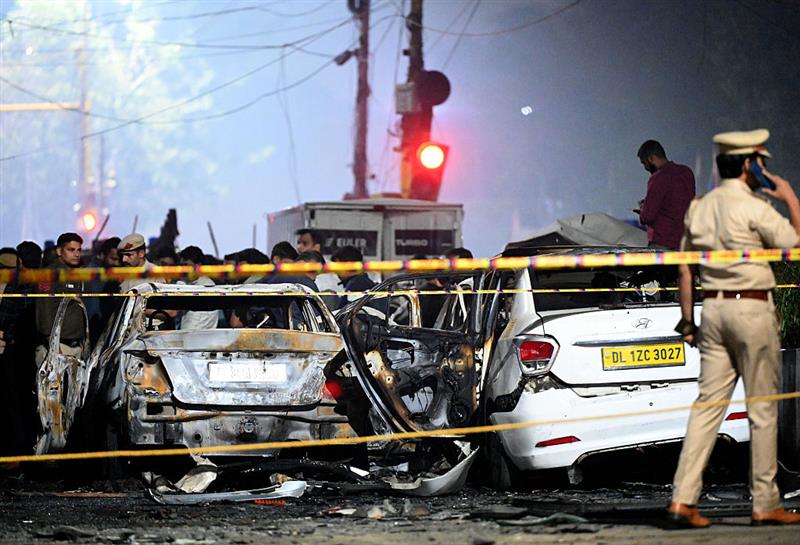
A powerful car bombing near Delhi’s Red Fort Metro Station has ratcheted up existing tensions between Delhi and Islamabad. While a motive for the 10 November attack is yet to be specified, the perpetrator and a co-conspirator were from Kashmir, which is the subject of ongoing territorial disputes between India and Pakistan. The Indian government has been reluctant to explicitly link the attacks to Pakistan or Pakistan-based terrorist groups, such as Jaish-e-Mohammed (JeM), but some commentators have nonetheless drawn such connections.
The terror attack killed at least 13 people and injured around 20. While it remains to be seen how the government will respond to this attack, in May Prime Minister Narendra Modi said ‘any future act of terror will be treated as an act of war’. In that same month, India and Pakistan went through a short, intense aerial conflict following an April terrorist attack in Pahalgam, Kashmir, which killed 25 tourists and was linked to the Resistance Front, a Pakistan-based group.
In a major intelligence victory just hours prior to the blast, the Jammu and Kashmir police recovered about 3,000 kg of explosives from two rented apartments in Faridabad, linked to a medical professional working in a local hospital in the city. The confiscated materials included 350 kg of ammonium nitrate, commonly used in explosives for terror attacks. India’s national Forensic Science Laboratory has collected more than 40 samples from the blast sites. An official from the organisation said that one of the materials used in the blast was ammonium nitrate, but a second sample pointed to something more powerful.
Several reports have outlined the sequence of events that evening. However, some confusion persists, including about whether the explosion was accidental or intentional. Based on a number of arrests made since the blast, Indian intelligence sources believe that a ‘Pakistan-backed Jaish-e-Mohammed “white-collar” terror network of medics’ were planning six bombings across six cities on 6 December, the anniversary of the demolition of the Babri Masjid, a disputed site claimed by both Hindus and Muslims that was destroyed by a Hindu nationalist mob in 1992. This led to riots and killings, heightening existing religious tensions.
The intelligence around the planned bombings arose from the interrogations of Shaheen Shahid, Parvez Sayeed Ansari and Muzammil Ahmad Ganaie, who were among those arrested during the investigation. The three, who were reportedly part of a JeM-linked terror module, had been raising funds and coordinating logistics for the attacks.
At a meeting following the attack, Indian Cabinet members called the bombing ‘a heinous terror incident, perpetrated by anti-national forces,’ but did not provide any new evidence to support that attribution. At the same meeting, union minister Ashwini Vaishnaw said the investigation would be ‘pursued with utmost urgency and professionalism, so that the perpetrators, their collaborators and their sponsors are identified and brought to justice without delay.’ He also affirmed ‘India’s unwavering commitment to a policy of zero tolerance towards terrorism in all its forms and manifestations.’
Even amid these statements, the Indian government has been cautious in officially attributing the attack to Pakistan or even JeM, though unnamed investigators have pointed to the group. This cautious approach appears to be the result of the loud rhetoric following the Pahalgam attacks and the resultant military clashes. This leads to a type of commitment trap where decision-makers feel constrained by peacetime promises that cannot always be translated into action in a crisis.
India–Pakistan tensions have been high for several years and were worsened by this year’s clashes. Despite India’s successes in the short conflicts in April and May, it was let down by a poorly calibrated and lumbering public diplomacy effort that left its people deeply unsatisfied. Since then, geopolitical issues have also put the Indian government on the defensive. Despite early hopes in New Delhi that the Trump administration would view it favourably, India found itself subject to ruinous tariffs for reasons that remain unclear. Some Indian analysts also believe that the United States is treating Pakistan better than it is treating India, for example by backing Pakistan’s claims about Indian fighter jet losses in the clash. Pakistan appears to have taken a lead by unexpectedly strongly endorsing President Donald Trump’s bid for a Nobel Peace Prize. Meanwhile, Pakistan also retains strong Chinese support. India’s efforts to rebuild ties with China are making some progress, but they are unlikely to ever be as good as Pakistan’s.
It remains unclear how India will respond to the Red Fort attacks. The fact that Indian intelligence agencies had discovered the broader plot before the bombing may reduce the pressure on the Indian government to respond with overt force. The Indian government’s rhetoric is much less harsh than it was after the April attack, which also suggests that it may not respond with military force. On the other hand, compared with a decade or so ago, India has shown that it is far less constrained by concerns about escalation. Pakistan’s continued reliance on terror as a strategy may still result in further clashes.